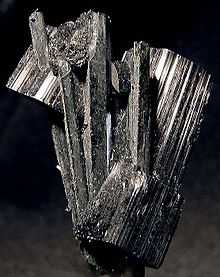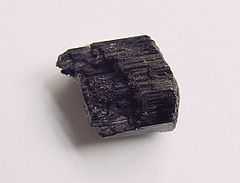Arfvedsonite
| Arfvedsonite | |
|---|---|
|
Arfvedsonite from New Hampshire, USA | |
| General | |
| Category |
Inosilicates Amphiboles |
| Formula (repeating unit) | [Na][Na2][(Fe2+)4Fe3+][(OH)2|Si8O22] |
| Strunz classification |
09.DE.25 VIII/F.08-100 |
| Dana classification | 66.1.3c.9 |
| Identification | |
| Color | Black, deep green on thin edges |
| Crystal habit | Fibrous, radial prismatic aggregates |
| Crystal system | Monoclinic – Prismatic |
| Twinning | Simple or lamellar parallel to [100] |
| Cleavage | Perfect on [110] |
| Fracture | Uneven |
| Tenacity | Brittle |
| Mohs scale hardness | 5–6 |
| Luster | Vitreous |
| Streak | Deep bluish gray, gray-green |
| Diaphaneity | Translucent to opaque |
| Specific gravity | 3.3–3.5 |
| Optical properties | Biaxial (-) |
| Refractive index |
nα = 1.652–1.699 nβ = 1.660–1.705 nγ = 1.666–1.708 |
| Birefringence | δ = 0.014 |
| Pleochroism | Strong: Blue-greens, yellow-browns, gray-violets |
| Dispersion | r > v strong |
| References | [1][2][3][4] |
Arfvedsonite is a sodium amphibole mineral with composition: [Na][Na2][(Fe2+)4Fe3+][(OH)2|Si8O22]. It crystallizes in the monoclinic prismatic crystal system and typically occurs as greenish black to bluish grey fibrous to radiating or stellate prisms.
It is a rather rare mineral occurring in nepheline syenite intrusions and agpaitic (peralkaline) pegmatites and granites as the Golden Horn batholith in Okanogan County, Washington (type locality for zektzerite). Occurrences include Mont Saint-Hilaire, Quebec, Canada; the Ilímaussaq complex in Southern Greenland; and in pegmatites of the Kola Peninsula, Russia. Its mineral association includes nepheline, albite, aegirine, riebeckite, katophorite and quartz.[1]
Arfvedsonite was discovered in 1823 and named for the Swedish chemist Johan August Arfwedson (1792–1841).[3]
See also

References
| Wikimedia Commons has media related to Arfvedsonite. |
- ↑ 1.0 1.1 Arfvedsonite. Handbook of Mineralogy
- ↑ Arfvedsonite. Mindat.org
- ↑ 3.0 3.1 Arfvedsonite. Webmineral
- ↑ IMA Master List
- Deer, W.A., R.A. Howie, and J. Zussman (1963) Rock-forming Minerals, v. 2, Chain Silicates, p. 364–374
- Mineral Galleries
